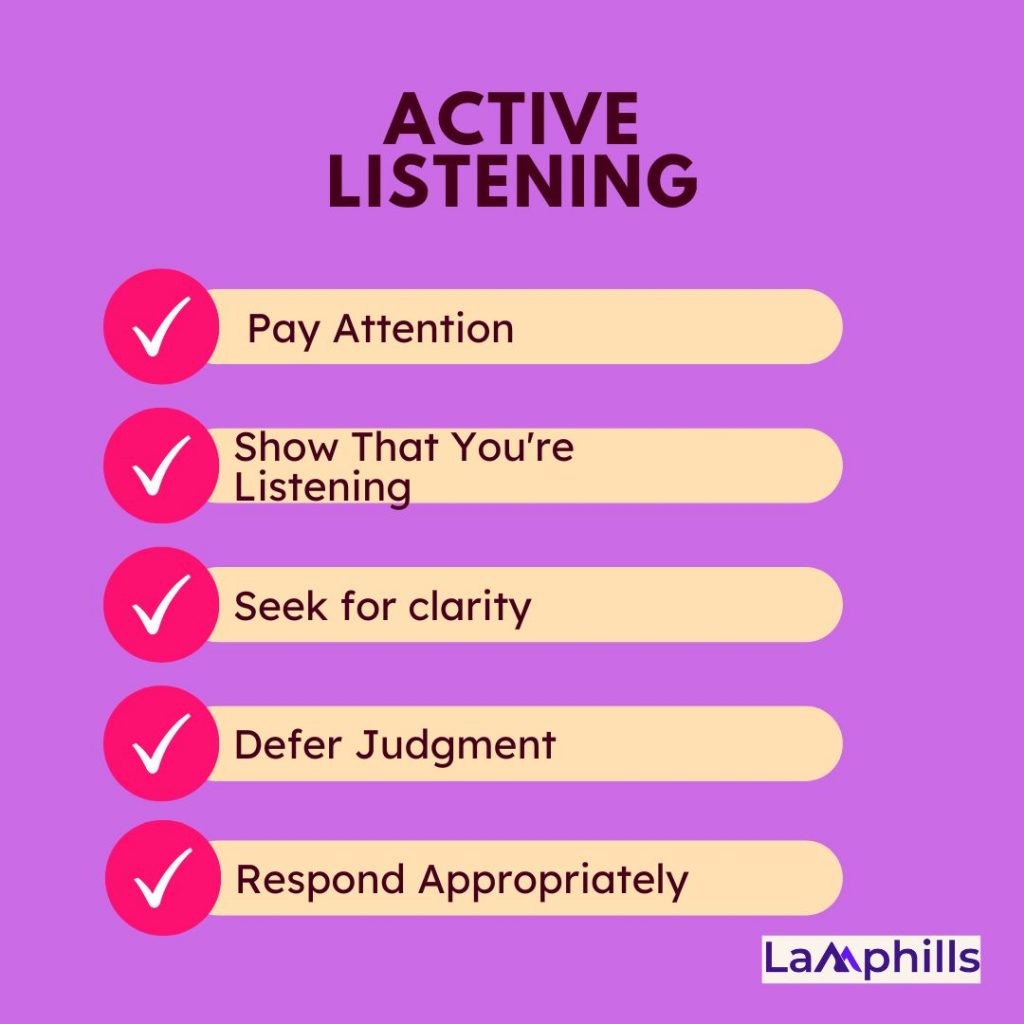Have you ever had a conversation with someone, and at the end of the day, it felt obvious that the person didn’t understand a thing about what you said? You can blame it on several factors, but the root cause is poor listening skills. As a PR professional, I’ve engaged in countless conversations, each presenting challenges and opportunities. Through experience, I’ve understood that mastering different listening styles isn’t just a skill—it’s an art form. It’s about more than just hearing; it’s about truly understanding, empathizing, and connecting with others on a deeper level. Hence, in this chapter, I’ll show you how to adopt some basic listening styles to help you connect with various speakers, notwithstanding the situation.
Key Takeaways
Listening styles refer to the general manner in which individuals receive and process information during interpersonal communication.
Common listening styles include active, reflective, analytical, and appreciative listening.
- Active listening involves paying attention to what the person is saying and not getting distracted by what’s happening around you or in your mind.
- Reflective listening involves reflecting on what the speaker is saying and communicating it back to them to confirm you understood correctly.
- Analytical listening focuses on facts, data, and measurable information; you carefully dissect and examine the content of communication to identify patterns, implications, and underlying messages.
- Appreciative listening involves actively acknowledging and appreciating the speaker’s perspectives, emotions, and experiences.
What Are Listening Styles?
Listening styles refer to the general manner in which individuals receive and process information during interpersonal communication. These styles encompass various techniques, attitudes, and behaviors that influence how people engage with and interpret spoken messages. You can employ different listening styles depending on the context, the nature of the interaction, and your personal preferences and objectives. Common listening styles include active, reflective, analytical, and appreciative listening, each characterized by unique features and outcomes. We’ll study each of these in detail.
Types of Listening Styles
Active Listening

When you practice active listening, you consciously try to hear the words and understand the message. This involves paying attention to what the person is saying and not getting distracted by what’s happening around you or in your mind.
Agreed, it can be easy to get bored while listening to someone speak for some time, but one of the ways to overcome this is by mentally repeating the person’s words as they say them. This will help you stay active and focused.
The Benefits of Active Listening
Being an active listener helps you improve your productivity and your ability to influence people. It can even help you avoid conflicts and misunderstandings. Why? Because when you practice active listening, you give the speaker that you understand and agree with what they’re saying, even if you don’t. Nobody likes to feel that they’re just pouring water on a brick wall, and that’s the impression you give when you listen absent-mindedly.
How To Practice Active Listening

Here are some tips to help you practice effective active listening:
#1. Pay Attention
Active listening involves paying attention; give your speaker that undivided attention while acknowledging their message. Also, recognize that body language speaks volumes, so keep your body movements in check. Don’t mentally prepare a rebuttal; it will prevent you from getting the speaker’s message.
#2. Show That You’re Listening
Listen with your body, not just your ears. Your body language should affirm that you’re paying attention. Nod occasionally, smile, and use facial expressions accordingly. Encourage the speaker to continue by saying “yes,” “really?” etc…
#3. Seek for clarity
Sometimes, you might be paying attention but still find that what you understand differs from what the person meant. It’ll be helpful to reflect on what is being said and ask questions where necessary. You can say, “ I understand that… is this what you really mean?” This will reassure the speaker that you’re intentional about understanding how they feel.
#4. Defer Judgment
Don’t try to interrupt the speaker; allow the person to finish before you ask questions or bring up counterarguments.
#5. Respond Appropriately
The essence of active listening is that you understand the message well and respond accordingly. Be empathetic and honest in your response; even if you don’t agree with the speaker, assert your opinions respectfully without downplaying theirs.
The second type of listening style is reflective listening…
What is Reflective Listening?
When you practice reflective listening, you try to understand the speaker’s idea and then communicate it back to them to confirm you understood correctly. Unlike active listening, you reflect on what the speaker is saying to understand better; you occasionally ask questions to ensure you know the person’s feelings.
I once faced a crisis when I handled a project involving a team of professionals. We achieved a level of productivity initially until things went uphill. During my meetings with each member of the team, we had continuous back and forths; I would ask questions at every instance to ensure I understood what each person was saying, but we were finally able to identify the root cause of the problem as they gradually opened up on the issues they faced while on the job. I was careful not to infuse my preconceived opinions, and the result was outstanding.
There are two ways you can go about reflective listening. You can choose the paraphrasing method involving listening to the speaker and using your own words to reflect what they said. With this, you’ll know if you understood the speaker clearly. Another method is the mirroring method, where you simply repeat the key parts of the message, word for word. This method will help you stay focused on the rest of the message. I’d advise you to use the first method as that will ensure you understand the topic being discussed well.
Steps for reflective listening
The steps involved in reflective listening are similar to active listening:
#1. Listen to the speaker’s message
Make a conscious effort to focus solely on listening to what the other person has to say. Although most conversations start with that intention, the mind tends to lose focus and move its attention to other issues. Be intentional about listening to the speaker.
#2. Analyze the meaning of the speaker’s message
After listening to a thought or an idea, the next step should be determining what the speaker meant to communicate to you through those words. You must make an effort not to let your own opinions on the matter influence your analysis, as the purpose is not to combat the speaker’s ideas but rather to make sure that you properly understand them.
#3. Reflect the message to the speaker
After grasping the message the speaker is trying to communicate, you should confirm that your interpretation of the message is the same as what the speaker intended. You can do this either by repeating parts of their message word for word or by paraphrasing it. Also, try to reproduce elements like body language and tone of voice, as they are likely to be an integral part of the message.
#4. Confirm that you properly understood the message
The speaker is likely to have a response to your reflection. The response is usually either a confirmation that you properly understood what they are trying to say or a correction in which they explain their point further and try to help you know what they meant to say.
Note
Rather than simply repeating the facts and ideas that the speaker expresses, practicing reflective listening should be an attempt to understand the speaker’s feelings about the matters they talk about. You may instinctively be tempted to make judgments and counter the speaker’s opinions, but always remember that understanding the message is the priority. Also, resist the urge to offer advice. Over time, I’ve learned that people know what they ought to do most of the time; they just need to voice their concerns first. Knowing this, I use words of acknowledgment and encouragement to guide them to sort out their issues themselves.
The third listening style is analytical listening…
Analytical Listening

Analytical listening focuses on facts, data, and measurable information; you carefully dissect and examine the content of communication to identify patterns, implications, and underlying messages. This listening style requires critical thinking since you’re not paying so much attention to the speaker’s tone and body language; you’re listening to obtain facts to implement a strategy. This listening style is often used when carrying out a project with a highly analytical procedure.
In a meeting, the analytical listener provides a “reality check” to the rest of the team. During brainstorming, they review the information presented for accuracy, weed out the impractical, identify what’s feasible, and recommend the best implementation processes.
Characteristics of Analytical Listening
Key characteristics of analytical listening include:
#1. Critical Thinking
Analytical listeners employ critical thinking skills to question assumptions, evaluate evidence, and draw informed conclusions. They approach information with a healthy skepticism, seeking to validate or challenge ideas based on logic and evidence.
#2. Objectivity
Analytical listeners strive to maintain objectivity and impartiality in their assessments. Just like with other listening styles, they set aside personal biases and emotions to focus on the facts and evidence presented, allowing them to arrive at more accurate interpretations.
#3. Attention to Detail
Analytical listeners pay close attention to details in communication. They listen not only to the words spoken but also to tone, body language, and context, recognizing that these factors contribute to the overall message.
#4. Inquisitiveness
Analytical listeners are naturally curious. They ask probing questions, seek clarification, and explore alternative perspectives to comprehensively understand the topic at hand.
Tips for Improving Your Analytical Listening Skills
Here are some tips to help sharpen your analytical listening skills:
#1. Active Engagement:
Actively engage with the speaker by asking questions, seeking clarification, and paraphrasing key points. This demonstrates your interest and encourages deeper exploration of the topic.
#2. Reflective Practice
Take time to reflect on your listening experiences and identify areas for improvement. Consider how your biases, assumptions, and preconceptions may influence your interpretations, and strive to approach communication openly.
#3. Synthesize Information
Practice synthesizing information from multiple sources to comprehensively understand complex topics. Compare and contrast different perspectives and look for common themes and patterns that emerge.
#4. Critical Reading
Yes, reading can improve your listening skills. Engaging in critical reading can extend your analytical listening skills to written communication. Analyze the author’s arguments, evidence, and reasoning and consider how they contribute to the overall message.
The last listening style we’ll discuss in this chapter is appreciative listening…
Appreciative Listening

Appreciative listening is characterized by a genuine, positive, open-minded approach to understanding others. Unlike other listening styles that focus on problem-solving or critical analysis, you listen to find value and beauty in the messages conveyed by others. It involves actively acknowledging and appreciating the speaker’s perspectives, emotions, and experiences.
Here are some key characteristics of appreciative listening:
#1. Positivity
Appreciative listeners approach conversations positively to uplift and validate the speaker’s thoughts and feelings.
#2. Openness
As an appreciative listener, you maintain an open mind and a non-judgmental stance, allowing the speaker to express themselves freely without fear of criticism or rejection.
#3. Empathy
You demonstrate empathy by actively trying to understand the speaker’s emotions and viewpoints, even if they differ from your own.
#4. Validation
You validate the speaker’s experiences and feelings, recognizing their significance and importance.
#5. Encouragement
Appreciative listeners provide encouragement and support, fostering a safe and empowering environment for expression.
Understanding Your Preferred Listening Style
Effective communication begins with self-awareness, and one of the fundamental aspects of self-awareness is understanding your preferred listening style. Your listening style influences how you engage with others, interpret information, and respond to communication cues. When you know your dominant listening style, you can leverage its strengths to become a more effective communicator. Here are some tips on how to understand and appreciate your preferred listening style:
Strategies for Identifying Your Dominant Listening Style
#1. Reflect on Past Interactions
Take a moment to reflect on your interactions with others. Consider how you typically respond during conversations. Do you actively engage with the speaker, offer supportive feedback, and ask probing questions? Or do you tend to listen more passively, focusing on the words being said without necessarily trying to understand the meaning?
#2. Seek Feedback from Others
Contact trusted friends, colleagues, or mentors and ask for their observations on your listening behavior. Their insights may provide valuable perspectives that enhance your understanding of your dominant listening style.
#3. Take a Listening Style Assessment
Several online resources offer listening style assessments designed to help individuals identify their preferred approach to listening. These assessments often provide detailed insights into the characteristics of different listening styles and offer personalized feedback based on your responses.
Adapting Your Listening Style for Different Situations
Effective communication is not one-size-fits-all; it requires adaptability and versatility, especially regarding listening. Just as different situations call for different approaches, they also demand varying listening styles to ensure clear understanding and meaningful interaction.
Flexibility is the cornerstone of effective communication; it helps you to navigate diverse social, professional, and personal settings easily. In listening, being flexible means recognizing that not all situations require the same approach and being willing to adapt accordingly. By embracing flexibility, you demonstrate your openness to understanding others’ perspectives and engaging with them in a manner that resonates with their needs and preferences.
Strategies for Adjusting Your Listening Style
#1. Assess the Context
Before engaging in a conversation, take a moment to assess the context and purpose of the interaction. Are you participating in a brainstorming session where creativity is encouraged, or are you attending a performance review that requires constructive feedback? Tailor your listening style to align with the goals and dynamics of the situation.
#2. Practice Empathy
Put yourself in the shoes of the speaker and try to understand their perspective, emotions, and underlying motivations. By empathizing with their experience, you can adjust your listening style to provide the support, validation, or guidance they need.
#3. Stay Present and Mindful
Stay attentive during conversations, actively focusing on the speaker’s words, tone, and body language. Avoid distractions and resist the urge to formulate responses prematurely. Instead, let go of preconceived notions and allow the conversation to flow organically.
#4. Adapt Your Verbal and Nonverbal Cues
Mirror the speaker’s communication style by adjusting your verbal and nonverbal cues accordingly. If they speak passionately, convey enthusiasm and encouragement through your tone and gestures. Conversely, adopt a more empathetic and reassuring demeanor if they express vulnerability or uncertainty.
Benefits of Mastering Different Listening Styles
What are the benefits of mastering these different listening styles?
- Enhanced Understanding: Active listening ensures a deeper understanding of others’ perspectives, leading to clearer communication and fewer misunderstandings.
- Strengthened Relationships: Reflective listening builds trust and empathy, nurturing stronger bonds and fostering a sense of mutual respect and appreciation.
- Improved Problem-Solving: Analytical listening encourages critical thinking and discernment, facilitating more effective problem-solving and decision-making processes.
- Increased Positivity: Appreciative listening cultivates a culture of appreciation and positivity, elevating morale and promoting a supportive and uplifting environment.
In Conclusion,
Effective communication begins with effective listening. By mastering different listening styles and honing our listening skills, we can live better lives and build stronger relationships, leading to improved problem-solving and increased positivity. As we navigate the complexities of personal and professional interactions, let us remember the power of active and empathetic listening in fostering meaningful connections and a culture of collaboration and understanding.
Related Articles
- Social Listening Software: Your Key to Understanding and Engaging Your Audience
- External Communication In Business: Strategies for Amplifying Your Business Voice
- Media Training Tactics for Business Success: Elevate Your Communication Skills for Unbeatable Presence
- How To End a Conversation Politely & Professionally: Detailed Tips






